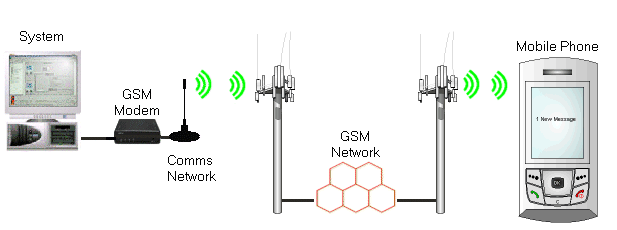Short Message Service (SMS) is a communications protocol specially designed for sending text messages between mobile telephone devices. It is used throughout the world.
The communications setup required for ClearSCADA to send SMS messages is similar to that for TAP - Telocator Alphanumeric input Protocol.

However, SMS has some key differences:
- Advantages:
- Your system is not reliant on the network service provider permitting dial in access to their network. This also means that your system is not affected if the network service provider does provide dial in access but uses a protocol not supported by ClearSCADA.
- Your system is not reliant on a conventional telephone line. Conventional telephone lines may not be available if the server is in a remote location, or may be available but extremely costly.
- Disadvantages:
- The volume of messages that you can send is low in comparison to TAP and UCP. Both TAP and UCP allow you to send many more messages in a short space of time.
- SMS messages may be more costly to use as they invariably involve a greater cost per message.
For successful communications using the Pager driver, you need to use a GSM modem that supports the following protocol commands:
| Command | Purpose |
|---|---|
|
ATM0V1E0H0S0=0 |
This initial poll string consists of standard Hayes modem commands that turn on verbose mode and turn off echo, auto-answer, and speaker. They also check that the GSM modem is ready to send data. |
|
AT+CMEE? |
Requests the modem to respond with its error support number. The error support number indicates the level of error support that is provided by the modem. |
|
AT+CMEE=<n> |
Where <n> = 0-2 (the angle brackets < > are not included). This command sets the GSM modem to the highest available error-support mode (determined from the query). |
|
AT+CMGF=1 |
Puts the modem into Text mode so that it can send text characters, as required for sending SMS messages. |
|
AT+CMGS="<recipient number>" |
Identifies the mobile telephone to which the message is to be sent. The GSM modem responds to this with a prompt for the body of the message. You then enter the body of the message and the GSM modem sends the message to the telephone number defined in this command. When the message has been sent, the command is terminated by Ctrl-Z. |
|
AT+CSCS='GSM' |
Checks that the modem is set to use the GSM 03.38 character set so that non-Roman characters can be sent correctly. If the modem cannot be put into GSM 03.38 mode, an error occurs. |
|
AT+CNMI=3,2 |
Instructs the modem to route incoming messages to ClearSCADA for processing. |
|
AT+CSMP=17,167,0,8 |
Sets the DCS (Data Coding Scheme) for the modem. This is used for both sending and processing messages. You can set the Data Coding Scheme on the SMS Service Form (see Define the Data Coding Scheme for an SMS Service) |
|
AT+CSMP=17,167,0,0 |
Sets the DCS (Data Coding Scheme) for the modem. This is used for both sending and processing messages. You can set the Data Coding Scheme on the SMS Service Form (see Define the Data Coding Scheme for an SMS Service) |
|
AT+CSDH |
Instructs the modem to include detailed header information when forwarding the messages to ClearSCADA. ClearSCADA needs the header information for processing incoming messages, especially multi-page messages. |
These commands are supported by many GSM modems and are the only commands supported by the Pager driver.
For further information on this protocol, please refer to the Global System for Communications (GSM) document: Digital cellular telecommunications system (Phase 2+); Use of Data Terminal Equipment - Data Circuit terminating; Equipment (DTE - DCE) interface for Short Message Service (SMS) and Cell Broadcast Service (CBS) (GSM 07.05 version 5.5.0). This document can be searched for, and downloaded from, this website: http://pda.etsi.org/pda/queryform.asp